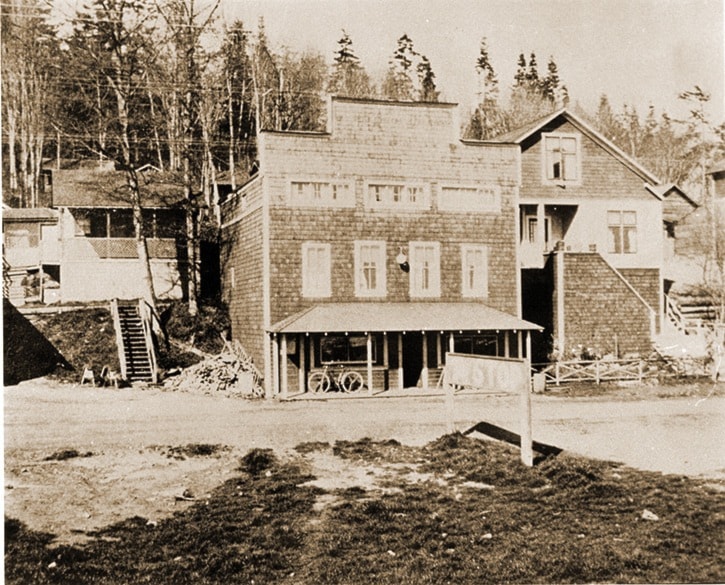Balmer’s Beach is not a familiar name in White Rock these days, but 90 years ago it was the place to be on a summer afternoon.
It’s now commonly known as East Beach.
The man for whom it was named was neither a pioneer nor a longtime resident, but he certainly put his stamp on his territory while he was here.
His daughter, Lorraine Killick, shared his story in 1978 at a meeting of the White Rock Historical Society:
I must go back to 1887 when my grandparents, Robert and Martha Ann Buckland, came from Ontario to settle in New Westminster. They had few material possessions, but over the years they raised a large family, and by hard work my grandfather prospered as a contractor. He was also an alderman and police commissioner in the city. Like many of their friends, they built a summer home in White Rock.
My father, Albert Edward Balmer, grew up in Toronto. He lost both his parents at an early age, and, after apprenticing as a mechanic, decided to come west in 1909.
 At 17, he must have felt he was a man. I can see him as presenting quite an image, arriving in New Westminster wearing diamond rings and stick pin, cigars carried in a silver case, and a meerschaum pipe.
At 17, he must have felt he was a man. I can see him as presenting quite an image, arriving in New Westminster wearing diamond rings and stick pin, cigars carried in a silver case, and a meerschaum pipe.
He was a very handsome man, tall, well-built with dark curly hair and flashing brown eyes. His personality made a great impact on all who knew him. I’m sure he must have swept my mother, Ann Ethel Buckland, off her feet when they met at a masquerade ball at Columbian College.
They were married in 1911, and my sister Stella was born a year later.
During the First World War, they lived in Toronto where my father worked in an aircraft plant. Returning to the west after the war, my parents could see the potential of a commercial development in White Rock.
They built a store, the Dew Drop Inn, in front of the Buckland summer home at the foot of Balsam Street and opened for business.
The third floor served as a dance hall. Publicity for the opening dance, held on July 1, 1919, stated that Balmer and Buckland Jr. were ‘making every arrangement for the comfort and pleasure for their patrons.’
This included two per cent beer, which my dad brewed.
Subsequently, they negotiated a foreshore lease with the Great Northern Railway, and my father built an ice cream parlour and bath house on the beach side of the tracks. Facilities for dancing and dining, and a pier which was little more than a docking ramp, were included.
Meanwhile, mother was busy running the store on the other side of the tracks. My dad had erected a large stop sign on the side of the road, which people apparently obeyed because the store flourished.
My mother became famous for her banana and coconut cream pies, sold at a dollar each.
My dad also built boats. He found a wreck on the beach which he took apart to make a pattern.
He built a number which he rented to rumrunners during prohibition. He often had to retrieve them the next day. He also built a launch that he used to go to the Gulf Islands to hunt. His shotgun he acquired from Mr. (Fred) Johnson, the customs man, in trade for his diamond stick pin.
The headline of the Vancouver Daily World newspaper dated Aug. 23, 1922, verifies Balmer’s involvement: “Provincial Police raiders make nine arrests: Men suspected of bootlegging taken from their beds.”
Among those arrested was A. E. Balmer, proprietor of the White Rock Athletic Club.
The late Don Munro wrote of those times, “During dark winter nights when clouds obscured the moon and tides were high, this was a departure point for running liquor out across the border.”
Prohibition had been enacted in the U.S. in 1920, which caused the bootlegging business in Canada to boom.
And where more ideally located for facilitating the distribution than White Rock: by rail, road – and water.
Despite the notoriety, or perhaps because of it, Balmer’s legitimate business flourished.
It was reported that 140 cars were packed into the parking space at Balmer’s Beach one June Sunday in 1925.
Whether he tired of it or yearned for a more settled lifestyle, Balmer sold out in 1924.
Lorraine continued:
My father decided to study to become a chiropractor. Both my parents enrolled in the Pacific Chiropractic College in Portland, Oregon.
My mother dropped out in the spring of ’24 when she realized she was pregnant with me. After 12 years of wanting another child, the change in their lives brought me.
Balmer graduated in 1925, and set up practice in Vancouver until the depression dried up his business.
He returned to his trade as a machinist, working for the American Can Company until he died suddenly in 1962.
Lorraine remembered her father as “a vital man with many hobbies. He kept bees, raised tropical fish, had over 200 canaries and lovebirds in the aviary he built in the yard and belonged to the cactus society. He would get me up in the middle of the night to admire a cactus in bloom.”
In many ways, Albert Balmer was typical of the age in which he lived, undaunted by the challenge of new enterprises.
He deserves his place in White Rock history.
The Peninsula’s best-known mother-and-son historians, Lorraine and Hugh Ellenwood, are dedicated to preserving history through the White Rock Museum & Archives. Call 604-541-2222, or email whiterockarchives@telus.net
